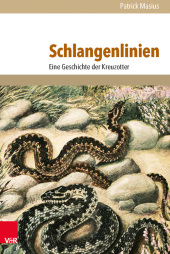 Neuerscheinungen 2014Stand: 2020-02-01 |
Schnellsuche
ISBN/Stichwort/Autor
|
Herderstraße 10
10625 Berlin
Tel.: 030 315 714 16
Fax 030 315 714 14
info@buchspektrum.de |

Patrick Masius
Schlangenlinien
Eine Geschichte der Kreuzotter
2014. 200 S. mit 30 Abb. und 5 Tab. 23.2 cm
Verlag/Jahr: VANDENHOECK & RUPRECHT 2014
ISBN: 3-525-31714-X (352531714X)
Neue ISBN: 978-3-525-31714-3 (9783525317143)
Preis und Lieferzeit: Bitte klicken
Die Geschichte der Kreuzotter verläuft nicht linear, sondern in Schlangenlinien. Vom Heimatdichter Hermann Löns noch als "Ungetüm mit den roten Mörderaugen" charakterisiert, erfreut sich die Kreuzotter heute der Anerkennung als seltene und erhaltenswerte Art.
Most animals carry certain meanings framed by our cultural understanding. They are characterized in terms of usefulness, beauty, behavior etc. In the history of the only poisonous snake in Germany a significant change of perception can be shown. The Common Viper, first identified by zoologists in the 18th century became feared as a deadly monster. From 1900 onwards even state eradication programs were launched. With the rise of nature conservation, ideas about this snake slowly started to change. National persecution was officially stopped in 1930 and even aesthetic aspects were discovered. By the 1970s the Viper was not perceived as dangerous anymore but - on the contrary - as an endangered species. Explaining the way of how the cultural meaning in history developed, reveals fundamental aspects of where this meaning depends on. The answer lies not so much in a progression of knowledge, but more so in changing relations to the environment, materially and ideologically.
´Most animals carry certain meanings framed by our cultural understanding. They are characterized in terms of usefulness, beauty, behavior etc. In the history of the only poisonous snake in Germany a significant change of perception can be shown. The Common Viper, first identified by zoologists in the 18th century became feared as a deadly monster. From 1900 onwards even state eradication programs were launched. With the rise of nature conservation, ideas about this snake slowly started to change. National persecution was officially stopped in 1930 and even aesthetic aspects were discovered. By the 1970s the Viper was not perceived as dangerous anymore but on the contrary as an endangered species. Explaining the way of how the cultural meaning in history developed, reveals fundamental aspects of where this meaning depends on. The answer lies not so much in a progression of knowledge, but more so in changing relations to the environment, materially and ideologically.
Masius, Patrick
Dr. Patrick Masius ist als Postdoktorand am Lehrstuhl für Umwelt- und Ressourcenökonomik der Universität Göttingen tätig.


